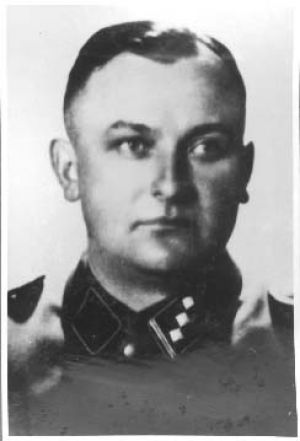Richard Thomalla

Richard Thomalla
Construction Expert for Aktion Reinhardt
Richard Thomalla was born on 23 October 1903, in Sabine-bei- Annahof (today, Sowin in Polish Silesia) in the Falkenberg District of Upper Silesia. A builder by profession, he was bi-lingual in German and Polish, and joined the SS on 1 July 1932, and the Nazi Party a month later. On 5 October 1935, he married Margarete Bruckner. He served his draft in Falkenberg and Oppeln and service in the SS in Wohlau (Wolow) and Breslau (Wroclaw) in the present-day south-eastern part of Polish Lower Silesia.
On 6 September 1940, Thomalla was transferred from Breslau to the General Gouvernement where he was a member of the SS Hilfspolizei (auxiliary police) in the cities of Czestochowa and Radom. On 22 August 1940, he was transferred by Friedrich-Wilhelm Krüger, HöhereSS- undPolizeiführer Ost who was based in Krakow to serve under SS- Brigadeführer Odilo Globocnik the SS undPolizeiführer for the Lublin District. From August –October 1940, Thomalla was a Section Leader of the SS –Border Defence Construction Service (SS Grenzschutz Baudienst) in Belzec, which stood on the demarcation line between the General Gouvernement and Soviet-occupied Galicia (Western Ukraine). His first task was the establishment of a construction depot of the Waffen-SS and Police in Zamość, about 40 kilometers north of Belzec.
After the German invasion of Russia, Thomalla was also in charge of constructing SS –Strongpoints (SS- Stutzpunkte) in the Ukraine with branch offices in Zwiahel and Kiev. He was recalled to Lublin in late 1941 / early 1942 to take over supervision of the latter stages of the first ‘Aktion Reinhardt’ death camp in Belzec. Thereafter, he also oversaw construction of the other two ‘Aktion Reinhardt’ camps at Sobibor and Treblinka; as such, he was the senior –SS officer at each site until the camps became operational. At Sobibor, one of the Polish railway workers Jan Piwonski recalled:
‘The next day a German SS soldier, who spoke very good Polish came to the station cafeteria. He came from Poznan or Silesia. When the woman behind the counter asked him what was being built there, he replied that she would find out soon enough, it was going to be a good laugh.’
In 1943, he headed Waffen-SS construction offices in Riga, the capital of Nazi-occupied Latvia, and Mogilew in White Russia. Later during 1943 -1944, Thomalla also played a role in the ‘pacification’ operation of the SS and police in the Zamość district. Thomalla was last seen in Zamość in June 1944, a few weeks before the entry of the Red Army into the town the following month. He was arrested by the Russian forces near Jicin, on the Czechoslovakian side of the Czech-Polish border. He was held in a special prison nearby for members of the SS and Nazi Party officials at Karthaus- Walditz (Kartouzy – Vladice). On 12 May 1945, Thomalla was ‘ordered out of his cell with his belongings.’ This was a typical order by the Soviet NKVD immediately before a prisoner was executed.
Sources
C.Webb & M. Chocholaty, The Treblinka Death Camp, Ibidem- Verlag, Stuttgart, 2014
Jules Schelvis, Sobibor, A History of a Nazi Death Camp, Berg, Oxford and New York, 2007
Richard Thomalla – Personal File – Yad Vashem
Photograph – Chris Webb Archive
© Holocaust Historical Society 2014


